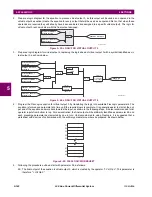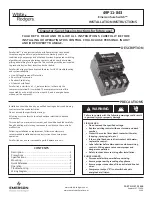
5-156
L90 Line Current Differential System
GE Multilin
5.6 GROUPED ELEMENTS
5 SETTINGS
5
c) STUB BUS
PATH: SETTINGS
GROUPED ELEMENTS
SETTING GROUP 1(6)
LINE DIFFERENTIAL ELEMENT
STUB BUS
The stub bus element protects for faults between two breakers in a breaker-and-a-half or ring bus configuration when the
line disconnect switch is open. At the same time, if the line is still energized through the remote terminal(s), differential pro-
tection is still required (the line may still need to be energized because there is a tapped load on a two terminal line or
because the line is a three terminal line with two of the terminals still connected). Correct operation for this condition is
achieved by the local relay sending zero current values to the remote end(s) so that a local bus fault does not result in trip-
ping the line. At the local end, the differential element is disabled and stub bus protection is provided by a user-selected
overcurrent element. If there is a line fault, the remote end(s) will trip on differential but local differential function and DTT
signal (if enabled) to the local end, will be blocked by the stub bus logic allowing the local breakers to remain closed.
•
STUB BUS FUNCTION:
There are three requirements for stub bus operation: the element must be enabled, an indica-
tion that the line disconnect is open, and the
STUB BUS TRIGGER
setting is set as indicated below. There are two meth-
ods of setting the stub bus trigger and thus setting up stub bus operation:
1.
If
STUB BUS TRIGGER
is “On”, the
STUB BUS OPERATE
operand picks up as soon as the disconnect switch opens,
causing zero currents to be transmitted to remote end(s) and DTT receipt from remote end(s) to be permanently
blocked. An overcurrent element, blocked by disconnect switch closed, provides protection for the local bus.
2.
An alternate method is to set
STUB BUS TRIGGER
to be the pickup of an assigned instantaneous overcurrent ele-
ment. The instantaneous overcurrent element must operate quickly enough to pick up the
STUB BUS OPERATE
operand, disable the local differential, and send zero currents to the other terminal(s). If the bus minimum fault cur-
rent is above five times the instantaneous overcurrent pickup, tests have confirmed that the
STUB BUS OPERATE
operand always pick up correctly for a stub bus fault and prevents tripping of the remote terminal. If minimum stub
bus fault current is below this value, then method 1 should be used. Note also that correct testing of stub bus oper-
ation, when this method is used, requires sudden injection of a fault currents above five times instantaneous over-
current pickup. The assigned current element should be mapped to appropriate output contact(s) to trip the stub
bus breakers. It should be blocked unless disconnect is open. To prevent 87L tripping from remote L90 relays still
protecting the line, the auxiliary contact of line disconnect switch (logic “1” when line switch is open) should be
assigned to block the local 87L function by using the
CURRENT DIFF BLOCK
setting.
•
STUB BUS DISCONNECT:
Selects a FlexLogic operand to represent the open state of auxiliary contact of line discon-
nect switch (logic “1” when line disconnect switch is open). If necessary, simple logic representing not only line discon-
nect switch but also the closed state of the breakers can be created with FlexLogic and assigned to this setting.
•
STUB BUS TRIGGER:
Selects a FlexLogic operand that causes the
STUB BUS OPERATE
operand to pick up if the line
disconnect is open. It can be set either to “On” or to an instantaneous overcurrent element (see above). If the instanta-
neous overcurrent used for the stub bus protection is set with a time delay, then
STUB BUS TRIGGER
should use the
associated instantaneous overcurrent
pickup
operand. The source assigned for the current of this element must cover
the stub between CTs of the associated breakers and disconnect switch.
STUB BUS
STUB BUS FUNCTION:
Disabled
Range: Disabled, Enabled
MESSAGE
STUB BUS DISCONNECT:
Off
Range: FlexLogic operand
MESSAGE
STUB BUS TRIGGER:
Off
Range: FlexLogic operand
MESSAGE
STUB BUS TARGET:
Self-reset
Range: Self-reset, Latched, Disabled
MESSAGE
STUB BUS EVENTS:
Disabled
Range: Disabled, Enabled
Содержание UR Series L90
Страница 14: ...xiv L90 Line Current Differential System GE Multilin 0 1 BATTERY DISPOSAL 0 BATTERY DISPOSAL 0 ...
Страница 68: ...2 34 L90 Line Current Differential System GE Multilin 2 4 SPECIFICATIONS 2 PRODUCT DESCRIPTION 2 ...
Страница 138: ...4 30 L90 Line Current Differential System GE Multilin 4 3 FACEPLATE INTERFACE 4 HUMAN INTERFACES 4 ...
Страница 604: ...9 58 L90 Line Current Differential System GE Multilin 9 6 FAULT LOCATOR 9 THEORY OF OPERATION 9 ...
Страница 652: ...A 16 L90 Line Current Differential System GE Multilin A 1 PARAMETER LISTS APPENDIX A A ...
Страница 772: ...B 120 L90 Line Current Differential System GE Multilin B 4 MEMORY MAPPING APPENDIX B B ...
Страница 802: ...C 30 L90 Line Current Differential System GE Multilin C 7 LOGICAL NODES APPENDIX C C ...
Страница 812: ...D 10 L90 Line Current Differential System GE Multilin D 1 IEC 60870 5 104 APPENDIX D D ...
Страница 824: ...E 12 L90 Line Current Differential System GE Multilin E 2 DNP POINT LISTS APPENDIX E E ...
Страница 834: ...F 10 L90 Line Current Differential System GE Multilin F 3 WARRANTY APPENDIX F F ...
Страница 846: ...xii L90 Line Current Differential System GE Multilin INDEX ...
















































